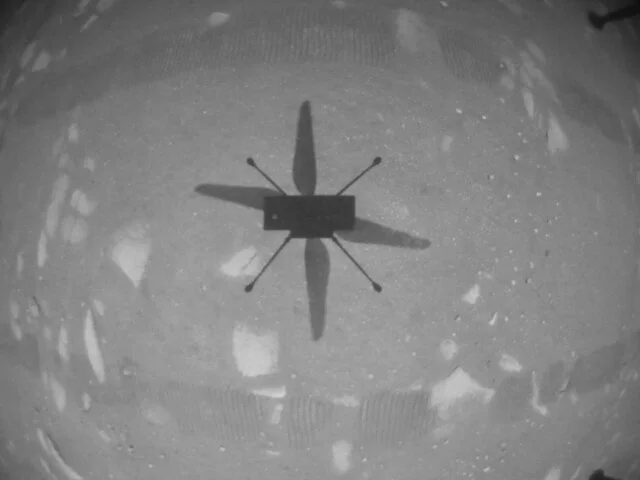11:30 AM (Monday) | *NASA’s Mars helicopter, Ingenuity, becomes the first aircraft to fly on another planet...click link at bottom of posting for just-released video*
Paul Dorian
NASA’s Ingenuity Mars Helicopter captured this shot as it hovered over the Martian surface on April 19, 2021, during the first instance of powered, controlled flight on another planet. It used its navigation camera, which autonomously tracks the ground during flight. Credit: NASA/JPL-Caltech
Overview
Earlier today, NASA’s Ingenuity Mars helicopter became the first aircraft to make a controlled flight on another planet. The solar-powered helicopter became airborne at 3:34 AM (ET) which was at a local time on Mars that was determined to likely feature optimal energy and flight conditions. Data indicates Ingenuity climbed to its prescribed altitude of 10 feet and maintained a stable hover for 30 seconds. It then descended and touched back down on the surface of Mars after logging a total of 39.1 seconds of flight. This was an important test for the helicopter which was full of unknowns as Mars has an extremely thin atmosphere and significantly lower gravity than Earth.
Details
This Mars mission began in late July 2020 with an Atlas V rocket launch at Cape Canaveral Space Station in Florida. More than six months later, the advanced rover named Perseverance and the helicopter named Ingenuity landed successfully on Mars and will spend the next couple of years searching for ancient life and exploring the planet’s surface.
Ingenuity which has now become the first rotorcraft used beyond Earth is only 19 inches tall and weighs just under 4 pounds. It had been tucked up in the belly of Perseverance since the summer of 2020. Ingenuity’s initial flight demonstration was autonomous – piloted by onboard guidance, navigation, and control systems running algorithms developed by the team at JPL. Because data must be sent to and returned from the Red Planet over hundreds of millions of miles using orbiting satellites and NASA’s Deep Space Network, Ingenuity cannot be flown with a joystick, and its flight was not observable from Earth in real time. To make the brief first flight, Ingenuity had to overcome Mars’s super-thin atmosphere which makes it more difficult for the helicopters’ blades, spinning at about 2,500 revolutions per minute, to generate lift. The Mars atmosphere is made up mostly of carbon dioxide with only 1% of the pressure at the surface compared to our planet and it has a significantly lower gravity – one-third that of Earth’s. Parked about 211 feet during Ingenuity’s historic first flight, the Perseverance rover not only acted as a communications relay between the helicopter and Earth, but also chronicled the flight operations with its cameras. The pictures from the rover imagers will provide additional data on the helicopter’s flight.
Ingenuity before Monday's flight, as seen from cameras aboard the Perseverance rover. © Handout/AFP/Getty Images
Deployed to the surface of Jezero Crater on April 3, Ingenuity is currently on the 16th sol, or Martian day, of its 30-sol (31-Earth day) flight test window. Over the next three sols, the helicopter team will receive and analyze all data and imagery from the test and formulate a plan for the second experimental test flight, scheduled for no earlier than April 22. If the helicopter survives the second flight test, the Ingenuity team will consider how best to expand the flight profile. If all goes according to plan, the helicopter could make as many as five flights in the coming weeks, each one more ambitious than the last. The second, for example, would fly slightly higher, to 16 feet, and then horizontally for a little bit before returning to the landing site.
Wright Brothers’ first flight photo courtesy airspacemag.com
Some final notes, as an homage to the Wright Brothers and some 118 years after their first flight at Kitty Hawk, North Carolina, the airfield on Mars will become known as “Wright Brothers Field”, in recognition of the two innovative bicycle makers from Dayton, Ohio. As another tribute to the Wright Brothers, Ingenuity has a postage-sized bit of fabric from the Wright Brothers aircraft known as the Flyer, attached to a cable under the solar panel.
Click here for just-released video of the flight of the helicopter from the Mastcam-Z imager on the nearby rover.
Meteorologist Paul Dorian
Perspecta, Inc.
perspectaweather.com



